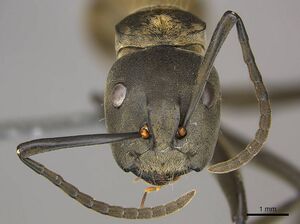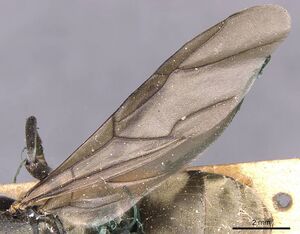Camponotus buchneri
| Camponotus buchneri | |
|---|---|

| |
| Scientific classification | |
| Kingdom: | Animalia |
| Phylum: | Arthropoda |
| Class: | Insecta |
| Order: | Hymenoptera |
| Family: | Formicidae |
| Subfamily: | Formicinae |
| Tribe: | Camponotini |
| Genus: | Camponotus |
| Subgenus: | Phasmomyrmex |
| Species: | C. buchneri |
| Binomial name | |
| Camponotus buchneri Forel, 1886 | |
| Subspecies | |
| |
| Synonyms | |
| |
Identification
Distribution
Latitudinal Distribution Pattern
Latitudinal Range: 2.4167° to -2.33157°.
| North Temperate |
North Subtropical |
Tropical | South Subtropical |
South Temperate |
- Source: AntMaps
Distribution based on Regional Taxon Lists
Afrotropical Region: Angola (type locality), Cameroun.
Distribution based on AntMaps
Distribution based on AntWeb specimens
Check data from AntWeb
Countries Occupied
| Number of countries occupied by this species based on AntWiki Regional Taxon Lists. In general, fewer countries occupied indicates a narrower range, while more countries indicates a more widespread species. |

|
Estimated Abundance
| Relative abundance based on number of AntMaps records per species (this species within the purple bar). Fewer records (to the left) indicates a less abundant/encountered species while more records (to the right) indicates more abundant/encountered species. |

|
Biology
Association with Other Organisms
 Explore: Show all Associate data or Search these data. See also a list of all data tables or learn how data is managed.
Explore: Show all Associate data or Search these data. See also a list of all data tables or learn how data is managed.
- This species is a host for the fungus Ophiocordyceps unilateralis (a parasitoid) (Quevillon, 2018) (encounter mode primary; direct transmission; transmission outside nest).
- This species is a host for the fungus Ophiocordyceps unilateralis (a pathogen) (Shrestha et al., 2017).
Castes
Images from AntWeb

| |
| Worker. Specimen code casent0250083. Photographer Peter Hawkes, uploaded by Curator Peter Hawkes AFRC. | Owned by AFRC, Pretoria, South Africa. |
  
| |
| Specimen code casent0900320. . | |
    
| |
| Worker. Specimen code casent0900950. Photographer Z. Lieberman, uploaded by California Academy of Sciences. | Owned by NHMUK, London, UK. |
    
| |
| Queen (alate/dealate). Specimen code casent0905181. Photographer Will Ericson, uploaded by California Academy of Sciences. | Owned by MSNG, Genoa, Italy. |
Nomenclature
The following information is derived from Barry Bolton's Online Catalogue of the Ants of the World.
- buchneri. Camponotus buchneri Forel, 1886f: 183 (w.) ANGOLA.
- Type-material: holotype worker.
- Type-locality: Angola: Malangé (M. Buchner).
- Type-depository: MHNG.
- Combination in Phasmomyrmex: Emery, 1920b: 252;
- combination in Phasmomyrmex (Phasmomyrmex): Emery, 1925b: 58;
- combination in Camponotus (Phasmomyrmex): Forel, 1912i: 90; Ward, et al. 2016: 349.
- Status as species: André, 1892a: 45; Dalla Torre, 1893: 223; Mayr, 1895: 151; Emery, 1896d: 376 (in list); Forel, 1913e: 671; Wheeler, W.M. 1922a: 256, 992; Santschi, 1923e: 293; Emery, 1925b: 58; Santschi, 1930b: 58; Bolton, 1995b: 316.
- Senior synonym of sericeus Stitz: Forel, 1910e: 421; Wheeler, W.M. 1911f: 170; Wheeler, W.M. 1922a: 992; Emery, 1925b: 58.
- Distribution: Angola, Cameroon, Congo, Democratic Republic of Congo, Gabon.
- Current subspecies: nominal plus camerounensis.
- sericeus. Phasmomyrmex sericeus Stitz, 1910: 146, fig. 11 (w.) CAMEROON.
- Type-material: 7 syntype workers.
- Type-localities: 5 workers Cameroon: Mundame (L. Conradt), 2 workers Cameroon: Lomie Dist. (Thesing).
- Type-depository: MNHU.
- [Unresolved junior secondary homonym of Formica sericea Fabricius, 1798: 279.]
- Junior synonym of buchneri: Forel, 1910e: 421; Wheeler, W.M. 1911f: 170; Wheeler, W.M. 1922a: 992; Emery, 1925b: 58.
Description
References
- Emery, C. 1920b. Le genre Camponotus Mayr. Nouvel essai de la subdivision en sous-genres. Rev. Zool. Afr. (Bruss.) 8: 229-260 (page 252, Combination in Phasmomyrmex)
- Forel, A. 1886h. Études myrmécologiques en 1886. Ann. Soc. Entomol. Belg. 30: 131-215 (page 183, worker described)
- Forel, A. 1910f. Note sur quelques fourmis d'Afrique. Ann. Soc. Entomol. Belg. 54: 421-458 (page 421, Senior synonym of sericeus)
- Forel, A. 1912j. Formicides néotropiques. Part VI. 5me sous-famille Camponotinae Forel. Mém. Soc. Entomol. Belg. 20: 59-92 (page 90, Combination in C. (Phasmomyrmex))
- Shrestha B, Tanaka E, Hyun MW, Han JG, Kim CS, Jo JW, Han SK, Oh J, Sung JM, Sung GH. 2017. Mycosphere Essay 19. Cordyceps species parasitizing hymenopteran and hemipteran insects. Mycosphere 8(9): 1424–1442 (DOI 10.5943/mycosphere/8/9/8).
- Ward, P.S., Blaimer, B.B., Fisher, B.L. 2016. A revised phylogenetic classification of the ant subfamily Formicinae (Hymenoptera: Formicidae), with resurrection of the genera Colobopsis and Dinomyrmex. Zootaxa 4072 (3): 343–357 (doi:10.11646/zootaxa.4072.3.4).
References based on Global Ant Biodiversity Informatics
- André E. 1892. Matériaux myrmécologiques. Rev. Entomol. (Caen) 11: 45-56.
- Dejean A., F. Azemar, R. Cereghino, M. Leponce, B. Corbara, J. Orivel, and A. Compin. 2015. The dynamics of ant mosaics in tropical rainforests characterized using the SelfOrganizing Map algorithm. Insect Science doi: 10.1111/1744-7917.12208
- Forel A. 1886. Études myrmécologiques en 1886. Annales de la Société Entomologique de Belgique. 30: 131-215.
- Forel A. 1913. Quelques fourmis des Indes, du Japon et d'Afrique. Rev. Suisse Zool. 21: 659-673
- Santschi F. 1923. Descriptions de nouveaux Formicides éthiopiens et notes diverses. I. Revue Zoologique Africaine (Brussels) 11: 259-295.
- Shattuck S. O. 1994. Taxonomic catalog of the ant subfamilies Aneuretinae and Dolichoderinae (Hymenoptera: Formicidae). University of California Publications in Entomology 112: i-xix, 1-241.
- Stitz H. 1910. Westafrikanische Ameisen. I. Mitteilungen aus dem Zoologischen Museum in Berlin 5: 125-151.
- Watt, A.D., N.E. Stork and B.Bolton. 2002. The diversity and abundance of ants in relation to forest disturbance and plantation establishment in southern Cameroon. Journal of Applied Ecology 39(1):18-30.
- Wheeler W. M. 1922. Ants of the American Museum Congo expedition. A contribution to the myrmecology of Africa. II. The ants collected by the American Museum Congo Expedition. Bulletin of the American Museum of Natural History 45: 39-269.
- Wheeler W. M. 1922. Ants of the American Museum Congo expedition. A contribution to the myrmecology of Africa. VIII. A synonymic list of the ants of the Ethiopian region. Bulletin of the American Museum of Natural History 45: 711-1004

